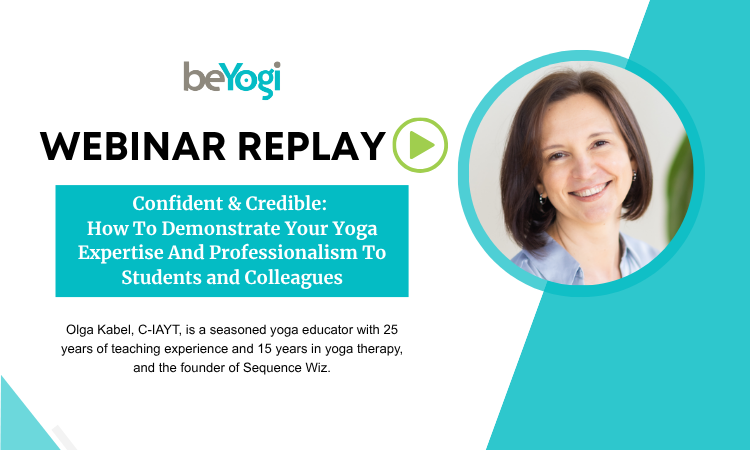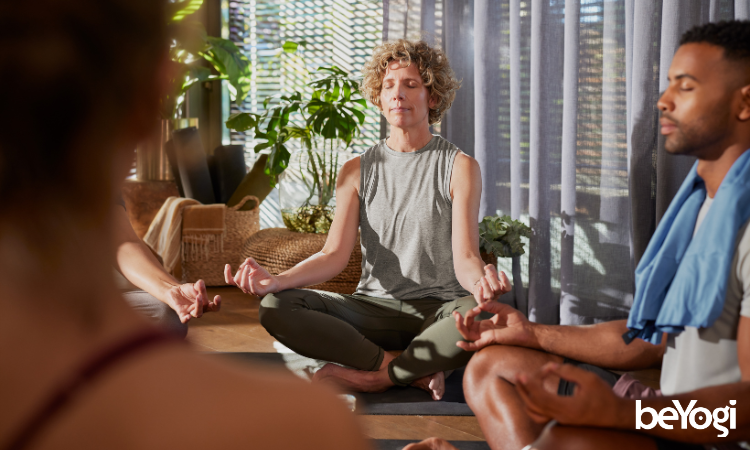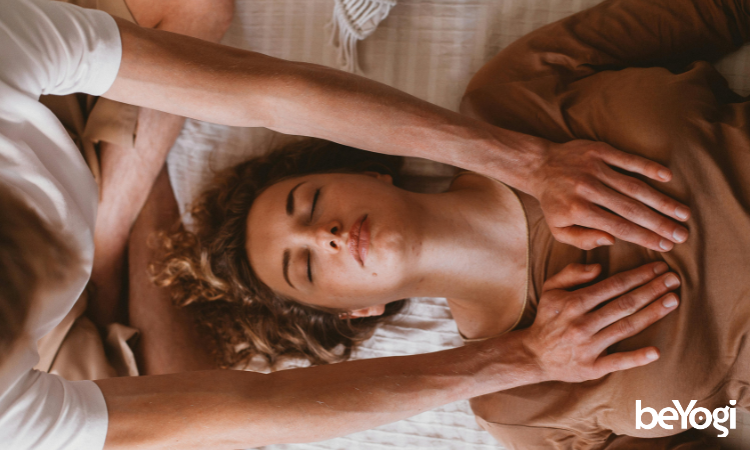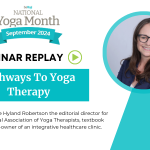
Pathways To Yoga Therapy: Taking The Next Steps In Your Yoga Career
October 11, 2024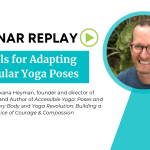
Skills For Adapting Popular Yoga Poses
October 18, 2024Teaching Yoga To Older People: A Practical Guide For Yoga Instructors

Yoga in general can be a challenging, rewarding career path. Add in the option to teach yoga for older people into the mix, and you're set up for an exciting way to change your students' lives for the better. Still, teaching yoga to older people is filled with unique challenges and considerations–this article highlights what every yoga instructor should know.
Some teachers look forward to having older people in class, while others almost dread it. If you fall into the latter category, don't worry. It doesn't always have to be that way.
It can seem daunting to provide a class suitable for various ages and abilities, but it is not impossible. With effort and practice, you may come to love it, just as I have. I have a soft spot for my senior yogis.
For years, I have taught a class almost exclusively for seniors, and it is undoubtedly my favorite class.
Why? Because their progress is so easily visible, and our efforts together truly affect their lives every day. When you teach older people, you impact their lives on and off the mat.
Yoga in general can be a challenging, rewarding career path. Add in the option to teach yoga for older people into the mix, and you're set up for an exciting way to change your students' lives for the better. Still, teaching yoga to older people is filled with unique challenges and considerations–this article highlights what every yoga instructor should know.
Some teachers look forward to having older people in class, while others almost dread it. If you fall into the latter category, don't worry. It doesn't always have to be that way.
It can seem daunting to provide a class suitable for various ages and abilities, but it is not impossible. With effort and practice, you may come to love it, just as I have. I have a soft spot for my senior yogis.
For years, I have taught a class almost exclusively for seniors, and it is undoubtedly my favorite class.
Why? Because their progress is so easily visible, and our efforts together truly affect their lives every day. When you teach older people, you impact their lives on and off the mat.
KEY TAKEAWAYS
- Yoga offers significant benefits for seniors, including improved mobility, balance, posture, cognitive function, respiratory function, and opportunities for socialization.
- Different yoga styles, such as Iyengar, Hatha, Slow Flow, Vinyasa, Ashtanga, Yin, and Restorative, can be adapted to meet the varying needs and abilities of seniors.
- Chair yoga is a popular and accessible option for seniors with mobility limitations, allowing them to practice yoga safely.
- Teachers should avoid underestimating seniors’ abilities while ensuring they are familiar with common health conditions like arthritis, diabetes, and osteoporosis to provide appropriate modifications.
- Effective verbal and visual cues, along with awareness of hearing or mobility challenges, help create a supportive environment for seniors.
- Making yoga spaces and classes welcoming and safe for seniors fosters inclusion, creativity, and cross-generational connection.
- Marketing should highlight seniors participating in yoga, encouraging them to join classes, and offering accessible information to foster community participation.
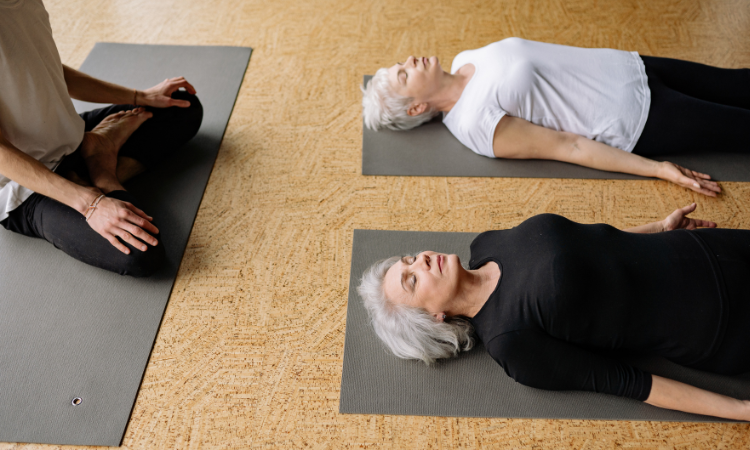
Yoga For Older People: What to Know
Benefits Of Yoga For Older People
One might argue that seniors benefit more from yoga than nearly any other age group, or at least that the benefits are often more noticeable, and there are facts to prove it. By 2030, one in six people globally will be over the age of 60 (WHO, 2022). As life expectancy increases, so does the need for fitness programs that cater to aging bodies and minds. Seniors stand to gain much from a regular yoga practice. Some of the best reasons for practicing yoga as a senior include:
- Maintaining Joint Mobility and Flexibility: Conditions like arthritis, osteoporosis, and general wear-and-tear can limit movement and cause pain. Yoga promotes joint mobility and flexibility through gentle movements, improving spinal flexibility and range of motion and reducing stiffness. It supports joint health by promoting the production of synovial fluid, which lubricates the joints and helps maintain smooth, pain-free movement. It encourages movement without the pressure that comes with many other physical activities.
- Better Balance and Posture: Balance becomes more challenging with age due to changes in muscle mass, joint flexibility, and coordination. Yoga helps reduce the risk of falls through poses like Tree Pose or Warrior III, which engage stabilizing muscles and improve proprioception (the awareness of body position). These poses enhance postural alignment and coordination, reducing the risk of falls. Yoga also improves core strength, which is key for balance and posture. Using drishti or a point of focus helps them train their eyes to help them balance in everyday activities.
- Building Strength and Stamina: Yoga is an excellent strength-building activity, especially with poses like Chair Pose, Modified Warrior I, or Plank. These poses enhance bone density, muscle mass, and overall physical stamina—important factors for maintaining independence. A flow style of practice can also provide cardiovascular benefits, promoting heart health.
- Improved Cognitive Function and Memory: The repetition that comes from sequences aids in memory. New poses and directions keep seniors constantly learning, which keeps their brains alert and active. Forgotten by many other forms of exercise and physical activity, yoga supports the mental and cognitive aspects of aging. Learning how to teach in a way that supports the aging process is a gift you can give to your students that keeps on giving.
- Alleviating Stress and Enhancing Mental Health: Yoga helps alleviate stress, anxiety, and symptoms of depression, all of which are common concerns for older adults facing isolation or cognitive decline. Breathwork and mindfulness activate the parasympathetic nervous system, reducing cortisol levels and promoting relaxation. Yoga's focus on relaxation also improves sleep quality, boosting overall mental well-being.
- Fostering Social Connection and Community: The top reason for senior depression and mental health concerns comes from isolation and loneliness. This is especially prevalent after retirement or when mobility becomes limited. When seniors can attend classes, especially with other seniors, it provides the opportunity for them to improve their mental health as well as their physical health. It connects them with others with similar circumstances, fostering a sense of community, support, and a sense of purpose. Online classes also provide these benefits for older people who are unable to leave their homes.
- Improved Respiratory Function: As we age, our lung function decreases due to posture, muscle atrophy, and other health challenges. Yoga encourages good posture and builds core and torso strength that can help improve lung function. Breathwork practices help strengthen the lungs. These practices are also effective at converting ineffective breathing patterns into deeper, more fulfilling breaths.
The Type Of Yoga Best For Older People
As the global population ages, there is an increasing demand for fitness programs designed to support older adults. Yoga, with its holistic benefits for both the body and mind, is a powerful tool to help older adults maintain mobility, strength, balance, and mental clarity. However, teaching yoga to this demographic requires a unique approach - one that emphasizes safety, accessibility, and compassion. Almost all types of yoga have the potential to help seniors gain strength and mobility if done safely.
If a senior is just getting active or is new to yoga, Iyengar and Hatha yoga are a great place to start. Iyengar emphasizes proper form and alignment, helping seniors learn how a pose feels in a safe manner. Hatha provides gentle movement without the strenuous poses found in some Vinyasa or Power yoga classes.
For seniors who are already active or are looking to gain both muscular and aerobic strength and endurance, look to Slow Flow or Vinyasa. These styles are in many ways variations of each other and help seniors focus on strength, endurance, and balance.
For seniors looking for a more disciplined and athletic approach that also exercises their working memory, Ashtanga may be a good option. It presents seniors with a challenging class, but one that becomes easier to follow with regular practice, making it an excellent tool for keeping the brain active.
For seniors looking to ease pain or tension, Yin and Restorative types of yoga are a great fit. Yin provides a deeper stretch that can be beneficial for connective tissue that tightens as one ages. Restorative aids seniors in relaxing and letting go of stress, and can improve the quality of their sleep.
Chair yoga has also become highly popular among seniors in the last several years. You can modify existing classes in almost all of these styles to work with a chair or create entirely new ones that revolve around poses that can be done with a chair. Learning to modify yoga for seniors will take you from dread to excitement when they walk into the room.
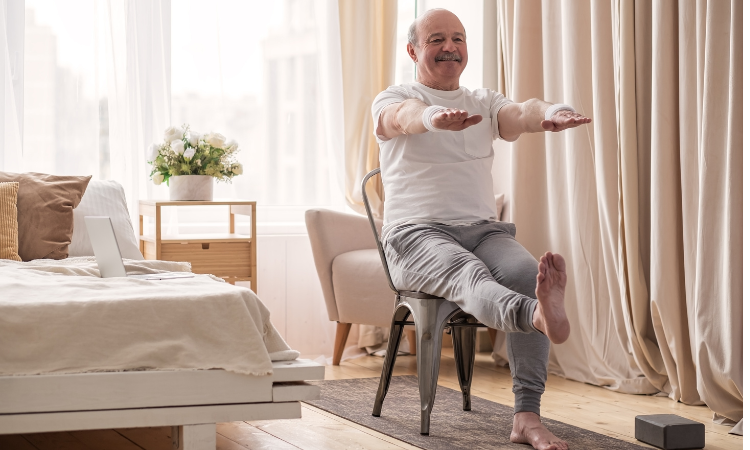
Health Considerations For Teaching Older Adult Bodies
Teaching yoga to older adults requires an understanding of the common health conditions they may face. When choosing a type of yoga to teach and sequencing your class, it is important to understand older bodies and what you may encounter when working with them. Here’s a breakdown of some common conditions and tips for adapting your practice:
- Arthritis affects major joints especially the hands, shoulders, spine, hips, and knees. It can cause stiffness, pain, and decreased range of motions.
- Tips: Use joint-friendly movements, offer longer warm-ups, and use props for support. Focus on gentle wrist rolls, hip circles, and fluid movements to ease stiffness.
- Osteoporosis reduces bone density, resulting in weaker, brittle bones, which increases the risk of fractures from strain or falls.
- Avoid: Overly deep forward folds and spinal flexion, twisting from the lumbar spine, and high-impact or jerking movements (like jumpbacks to a high plank before chaturanga).
- Use: Gentle or supported backbends, upright postures, and weight-bearing poses like Chair Pose.
- Heart Disease & Hypertension affect blood pressure, heart rate, and heart rhythm. They may require the monitoring of exertion levels throughout the practice.
- Avoid: Breath retention, some pranayama practices, excessive bandha use, strenuous flow sequences, inversions, and fast transitions between the ground and upright poses.
- Use: Restorative yoga, gentle breathwork, and supported poses with longer holds, more transitions or time to go from floor to standing and vice versa.
- Diabetes causes fluctuations in blood sugar and energy levels and may need to be monitored during practice.
- Tips: Encourage hydration, and be mindful of signs of fatigue or dizziness. A light snack post-practice can help maintain energy levels.
- Respiratory
Conditions
(COPD, Asthma) may result in a limited breathing capacity in both speed and depth.
- Avoid: Long or fast-paced practices.
- Use: Seated breathwork and pranayama with slow inhales and extended exhales.
How To Modify Yoga For Older People
Whether or not you regularly have seniors attending your classes, you should always be prepared for them to attend.
While it may seem nice to have everyone in your class be of similar abilities, it discourages people of different ages and abilities from attending. It can also stunt your growth as a teacher because you’re not forced to think outside the box and be creative in your modifications and teaching.
Try out the following tips to make your yoga classes senior-friendly:
- Don’t Underestimate Their Abilities: This is one of the most common mistakes I see in fitness professionals today. We are so afraid of “breaking” people, we are blind to what they really can do. Seniors are a case in point. I’ve seen 83-year-olds hold Warrior III better than some teachers I know. Encourage them to push themselves and try new things. Many seniors are nervous about getting injured, but many of those fears and risks can be assuaged by providing them with a safe environment. Encourage the use of props like chairs and walls for extra support, then let them shine. Learn to teach inclusive yoga classes that are comfortable for all.
- Learn About Common Senior Health Concerns: You can’t teach what you don’t know. One of the best ways to gain confidence in teaching seniors is by learning what health challenges seniors struggle with and how to modify yoga around them. Some of these include arthritis, diabetes, heart conditions, osteoporosis, and respiratory conditions. Study these conditions and then talk to people who have them. Find out what works for them and what doesn’t, then modify your classes accordingly.
- Use Effective Cues: When you teach, use both visual and verbal cues. Keep them simple and concise, giving students time to move their bodies. Some seniors may move more slowly to stay balanced, so provide extra time in between poses for students to transition. Also, be aware of the level of your voice. For seniors with hearing impairments, your regular teaching voice may be too quiet. Speak up and speak clearly for better understanding among all students. Avoid discouraging or ageist language in your classes and marketing.
Because older adults’ physical abilities can vary widely (this is certainly true among other age demographics as well), adaptive yoga techniques are beneficial and even essential in many classes. Many seniors are nervous about trying yoga for the same reasons most other people are. They assume that they’re not flexible enough. Aging can cause a loss of mobility, which often brings a loss of confidence with it. Provide variations and encourage your students of all ages to take them if they feel good. Four simple strategies for modifying your classes for all abilities that you can include in each class include:
- Integrate Chair Yoga for Clients with Mobility Challenges: Chair yoga allows clients with difficulty getting up and down from the floor to participate fully. Examples of chair yoga poses include Seated Cat-Cow, Chair Warrior I, and Seated Forward Fold. You may also chair-assisted classes. Participants who wish to do so have a chair next to their mat so they can move back and forth between their mat and their chair as they wish. This gives them choice and complete control over their practice to make it their own.
- Use Props Liberally: Props like blocks, straps, bolsters, and blankets help modify poses and ensure accessibility. Blocks can support seated forward folds, straps can assist in hamstring stretches, and bolsters offer comfort in restorative poses. Incorporate other props including the wall or chairs to offer other options as well. Prior to starting class, consider letting your students know a bit about what you’ll be doing so they can select their desired props or choose a spot near the wall.
- Slow Transitions: Encourage slow, intentional transitions to reduce the risk of injury. Take time moving from one pose to another and ensure students using a chair have it for support when needed. If you’re teaching mixed ability classes, offer variations for traditional sequences, such as the vinyasa or ashtanga flow (high plank, low plank/chaturanga, upward facing dog, downward facing dog), such as skipping the push-up and moving right into down dog or child’s pose for a resting transition.
- Listen to the Body: Help students learn to distinguish between discomfort and pain. Provide alternative poses and encourage self-compassion, reinforcing that yoga is about honoring one's body. Allow room for individual expression of poses and demonstrate variations throughout class so students feel comfortable and confident taking them.
- For more ideas on poses and variations for seniors, do research on how you can monitor and plan for any mobility challenges.
Class Design: Structure And Flow For Older Adults
Some of you may teach to a diverse clientele, while others may teach senior-centric classes. If you teach classes focused on older adults, your class design will look similar to other types of classes, with a few simple modifications to make your students comfortable. A well-structured yoga class for older adults should create a welcoming, safe, and empowering environment. Here's an effective class structure:
- Welcome and Check-In (5–10 minutes):Greet participants personally, inquire about any pain, injuries, or concerns, and foster a community atmosphere.
- Breathwork and Centering (5 minutes):Start with simple breath awareness or a gentle pranayama like three-part breath, either seated or reclined. Be mindful of breath retention practices for participants with hypertension or heart conditions.
- Gentle Warm-Up (10-15 minutes):Use slow joint rotations, shoulder rolls, neck stretches, cat-cow, and ankle circles. Always offer seated options for those with limited mobility. Focus on gentle dynamic movements and become aware of how long it typically takes your older students to warm up. On days with poor weather or after an illness or break from regular yoga, your participants may need additional warm-up time.
- Main Practice (20–30 minutes):
Your practice will vary greatly here, depending on the type of yoga you’re teaching. Incorporate the following elements in each class (though it can often be helpful to have a primary focus for the class to avoid overworking participants):
- Balance: While you may be tempted to avoid balancing poses with older people, do not. Balancing poses help seniors improve their balance and focus, and can be done safely. Try tree pose near a wall or holding onto a chair, boat pose, heel-to-toe walks, or weight shifting.
- Strength: Yoga helps older people build strength without weights or added strain on the body. Use chair pose, warrior poses (with modifications as needed), and supported lunges.
- Flexibility: Older people’s joints may have a more limited ability to stretch, so it is wise to offer various options and depths to stretch to. Reclined hamstring stretches, gentle side bends, and chest openers all aid in stretching areas that are often stiff. Offer chair-based or wall-supported alternatives, and provide demonstrations with and without props to help your participants feel capable and supported.
Be familiar with senior-friendly yoga poses and how to modify ones that aren’t inherently as welcoming.
- Cool Down and Stretch (10 minutes):Use supine twists, knees-to-chest, and happy baby for gentle release. Encourage longer holds in supported positions. If you generally include an inversion as part of your practice, offer variations to include all populations, such as a supported bridge or legs up the wall with props or a strap, or alternative poses for those with heart conditions or high blood pressure. Be aware that some older people may become dizzy when lying on their backs. A towel or block can be used to lift their head, or you may encourage a side-lying position or child's pose to make them more comfortable as you close the class and move into savasana.
- Savasana and Closing (5–10 minutes):Use props to support a comfortable savasana position (bolsters under knees, blankets over the body, head elevated). Encourage students to find a pose that is comfortable for them, and let them know that they do not have to take savasana in corpse pose if they find another position more comfortable. End with a guided meditation or body scan and a positive affirmation or intention. Invite them to rise slowly after savasana. This will help reduce dizziness or changes in blood pressure as they come back upright.
How To Start Teaching Yoga For Older People
With some background and direction on yoga for seniors, I hope you feel at least a tinge of excitement the next time an older person attends one of your classes.
Our world population as a whole is aging, and by 2030, the World Health Organization estimates that 1 in 6 people will be over the age of 60.
Seniors now, more than ever, are getting healthy and staying active further into their later years. Yoga has the potential to play a significant role in keeping our seniors healthy and independent. Now is the time to start making your current classes more inviting to seniors or start senior-focused yoga classes.
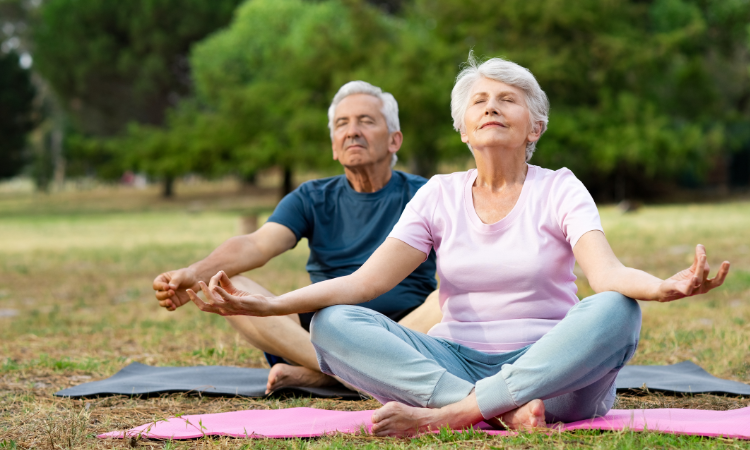
The first step is to ensure your classes and spaces are safe, effective, and enjoyable for all ages. Not only will it bring more people into your class, but it will encourage creativity on your part and connection among students of different generations.
Keep your space inviting and hazard-free. Know how to modify poses and classes for people of all abilities to prevent injuries. Maintain liability insurance to protect yourself and your business in the event of an accident or injury.
This is important for any demographic, especially when teaching seniors. The National Safety Council reports that 1 in 4 seniors fall each year, so liability coverage is a must-have to give you and your students peace of mind.
Next, craft compelling marketing that encourages seniors to be a part of the yoga community. Include pictures of seniors doing yoga in your advertising.
Make your websites and scheduling platforms accessible and easy to interact with. Be prepared to answer questions about what accommodations your facility has for seniors.
If you are in the position to do so, consider starting senior yoga classes. These classes are popular at senior centers, adult living communities, libraries, and community centers.
There is also a growing demand for senior classes at gyms and studios. Consider holding workshops, meet-and-greets, or other special events to help draw seniors into your facility.
They’ll get to know you, learn about classes, and see that this is something they can do. Often, all that’s needed is the invitation.
A Few Final Thoughts
Teaching yoga to older adults is not just a job—it’s an opportunity to enrich lives. You’re helping individuals move better, feel better, and connect more deeply with themselves and others. Many older adults become your most loyal, appreciative students, and their resilience, humor, and wisdom will continually inspire you.
If there is only one thing you take from this article, let it be encouragement. Encourage the seniors in your community to come and participate. Let them know that yoga is for them, that it’s for everybody. Start slow, keep learning, and be present. Help your students feel seen and strong in every class.
Yoga truly has the capacity to make their older years mobile, independent, and enjoyable.
Get Yoga Insurance & Protect Your Yoga Teaching Career Instantly
Save $24

